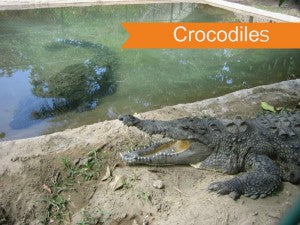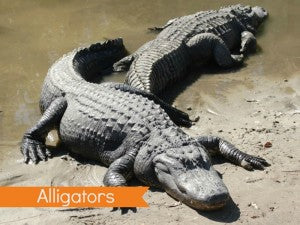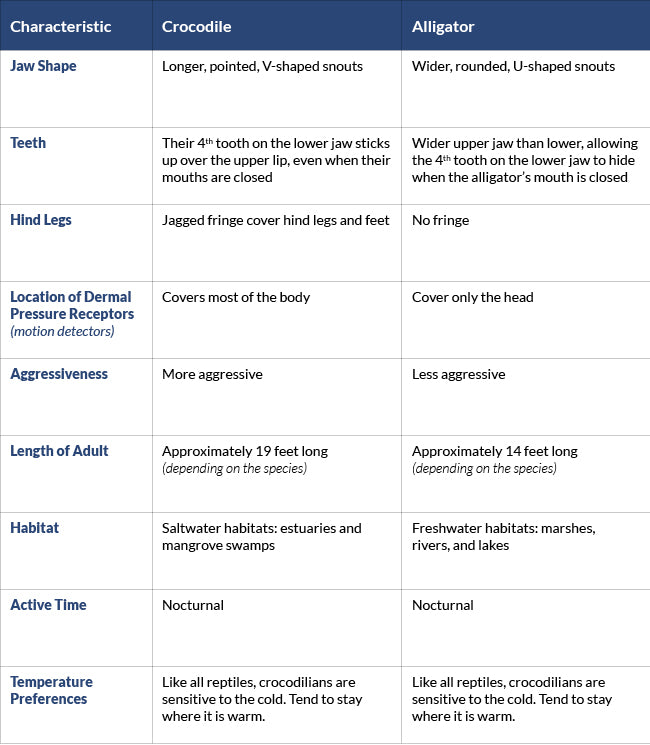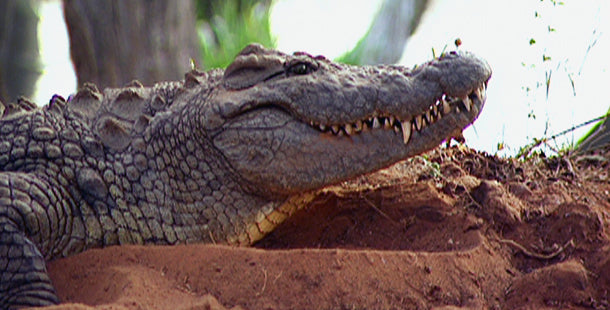
Photo Courtesy of San Diego Zoo
Two of nature’s most skillful predators are the alligator and crocodile. Why? Crocodiles and alligators will eat just about anything if given the chance, and they have all the predatory characteristics needed to make it happen. These intelligent, cold-blooded creatures wait underwater for prey to get close enough before they lurch into a surprise attack. Although they are both dangerous, crocodiles and alligators are not the same. They differ in appearance, habitat, and aggressiveness, which is important to understand if you’re ever attacked by or encounter one in the wild.What You Need to Know About Crocodiles and Alligators
According to the San Diego Zoo, there are about 23 species of crocodilians (the scientific order to which alligators and crocodiles belong) each with distinct characteristics. As crocodilians, alligators and crocodiles have a variety of similar and different characteristics.

Photos Courtesy of Diffen.com

What to Watch Out For
Crocodiles and alligators are extremely similar when it comes to their senses. All crocodilians have an amazing sense of smell, sight, and hearing, making them excellent predators. According to the San Diego Zoo, they even have special sense organs (Dermal Pressure Receptors) embedded throughout their skin. These sensors act as motion detectors to help crocs find prey in muddy water, where crocs happen to be most comfortable. Since they are most comfortable near the water, make sure to take extra caution if you plan to travel near saltwater or freshwater habitats in warm climate zones. Often, crocodilians camouflage themselves in the water, holding their breath for over an hour, and appearing to be nothing more than floating logs. It’s important to stay alert in these areas because it’s easier to avoid a croc altogether than to escape one. If you see a croc, whether lounging in the sun on land or floating just beneath the surface of the water, get away. Crocodilians can typically swim up to 20 mph, making it extremely dangerous for you to be in the water with them. The San Diego Zoo even states they “[move] with ease by using their powerful, oar-like tails and strongly webbed hind feet.” On land, crocs are a bit slower than in the water, but can still run for short distances up to 11 mph. When a croc does catch its prey, it will swallow it whole, unlike other carnivores who chew their food. If the prey is too large to swallow whole, the croc will tear off large pieces to eat. Once they have their prey in their jaws, they toss the food around to position it so it can easily slide down their throats when they tip their heads back. If a croc latches onto you for a meal, it’s pretty difficult to get away. Depending on the species, crocodilian bites can generate up to 5,000 pounds of pressure per square inch (a humans bite is only about 100 pounds). All of this pressure is what allows a croc to easily bite through clothes, bones, and just about anything else.How to Prevent an Attack
The best way to stay safe in crocodilian territory, which spreads across the southeastern United States and to the coastal areas of south Florida, is to avoid it altogether. However, if you do find yourself near infested waters, follow these tips from PBS.org to keep yourself safe and to prevent an attack.
Photo Courtesy of PBS.org
Alligators and Crocodiles:- Never, ever feed a crocodilian. Feeding an alligator or crocodile helps them lose their fear of people.
- Stay alert, especially at key feeding times near dawn and dusk.
- Don’t swim or wade in crocodilian infested water, if possible. If you have to, be sure to scan the water carefully for lurking predators that may look like floating logs.
- Don’t clean fish or feed ducks in croc habitats.
- Keep small children and pets away from the water’s edge. Alligators and crocodiles typically eat small prey, and nearly half of all known human fatalities were of children under the age of 12.
- When boating, don’t dangle arms or legs in the water.
- Stay at least 35 feet away from a gator or croc lounging on land. Although they rarely attack on land, they can move quickly—and you don’t want to stick around to see if they can actually catch you.
- Don’t disturb babies or nests (which look like big mounds). Mother crocs guard their nests closely.

11 comments
Karl G
Land Shark beer
Cathy Uchiek
What kind of beer was it?
Mathias
I have read that one way to open it’s jaw, is to insert into it’s throat a wooden stick long enough. The gag reflex will make it release their jaws.
DANIEL COPELAND
No a 22 cannot kill in the back of the head. It would be more dangerous to try that. Ricoshe into you may happen.
Jon
Lmao a 22 can’t even make it through a human head
Recon Specialist
We had one steal our beers, had the cooler on waters edge to prolong our ice. Bastard gator ever so gently bit it & wiggled back into the depths. He couldve hit one of us, but chose the beer. Explain that experts.
DA
Seems to me that the article lacks useful information. As an example; if a person can get off one shot, where is the best place to aim? Are we to assume that if attacked, or see another person in thier jaws that we just battle with bare hands? Can a .22LR penetrate the skull? If a person is fighting back only by poking em in the eye, you were too unprepared :-)
Jackson
We live in Mobile Al. where alligators are common,especially around the causeway. It is a shame about once every 5 years or so it will be on the news where a child or a dog got killed by a gator. Some one takes it for granted it is safe at the waters edge and they let their child or pet stray to close. If you go boating in the winter you can see the gators all along the banks of the rivers on a sunny day soaking up the sun. 12 footers are common. Common sense and logic are not as common as you think. Family from up north part of the country do not believe we have gators here just because they have never seen them themselves.
Jan
From central Florida. You should also know that many attacks are caused by walking your dog at the waters edge. To a gater, your pet looks like lunch.
Also in Florida
You will find crocs in the US, in South Florida near the Keys. They don’t stray much from that area, but somewhere in my collection of photos, I have a picture of the "Crocodile Crossing" sign on US-1.
Florida Dweller
Crocodiles don’t inhabit North America; only alligators do. I lived, swam and water-skied in a lake in central Florida for many years that contained numerous alligators, and they never once bothered anybody. Only the people who come from up north feed the beasts, encouraging them to come closer to our habitats, then wonder why they are eventually attacked. Don’t do that. Ever.